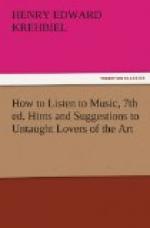Usually it is deference to the demands of a “programme”
that influences composers in extending the formal
boundaries of a symphony, and when this is done the
result is frequently a work which can only be called
a symphony by courtesy. M. Saint-Saens, however,
attempted an original excursion in his symphony in
C minor, without any discoverable, or at least confessed,
programmatic idea. He laid the work out in two
grand divisions, so as to have but one pause.
Nevertheless in each division we can recognize, though
as through a haze, the outlines of the familiar symphonic
movements. In the first part, buried under a
sequence of time designations like this: Adagio—Allegro
moderato—Poco adagio, we discover
the customary first and second movements, the former
preceded by a slow introduction; in the second division
we find this arrangement: Allegro moderato&mdas
h;Presto—Maestoso—Allegro,
this multiplicity of terms affording only a sort of
disguise for the regulation scherzo and finale, with
a cropping out of reminiscences from the first part
which have the obvious purpose to impress upon the
hearer that the symphony is an organic whole.
M. Saint-Saens has also introduced the organ and a
pianoforte with two players into the instrumental
apparatus.
[Sidenote: The Symphonic Poem.]
[Sidenote: Its characteristics.]
Three characteristics may be said to distinguish the Symphonic Poem, which in the view of the extremists who follow the lead of Liszt is the logical outcome of the symphony and the only expression of its aesthetic principles consonant with modern thought and feeling. First, it is programmatic—that is, it is based upon a poetical idea, a sequence of incidents, or of soul-states, to which a clew is given either by the title or a motto; second, it is compacted in form to a single movement, though as a rule the changing phases delineated in the separate movements of the symphony are also to be found in the divisions of the work marked by changes in tempo, key, and character; third, the work generally has a principal subject of such plasticity that the composer can body forth a varied content by presenting it in a number of transformations.
[Sidenote: Liszt’s first pianoforte concerto.]
The last two characteristics Liszt has carried over into his pianoforte concerto in E-flat. This has four distinct movements (viz.: I. Allegro maestoso; II. Quasi adagio; III. Allegretto vivace, scherzando; IV. Allegro marziale animato), but they are fused into a continuous whole, throughout which the principal thought of the work, the stupendously energetic phrase which the orchestra proclaims at the outset, is presented in various forms to make it express a great variety of moods and yet give unity to the concerto. “Thus, by means of this metamorphosis,” says Mr. Edward Dannreuther, “the poetic unity of the whole musical tissue is made apparent, spite of very great diversity of details; and Coleridge’s attempt at a definition of poetic unity—unity in multiety—is carried out to the letter.”




